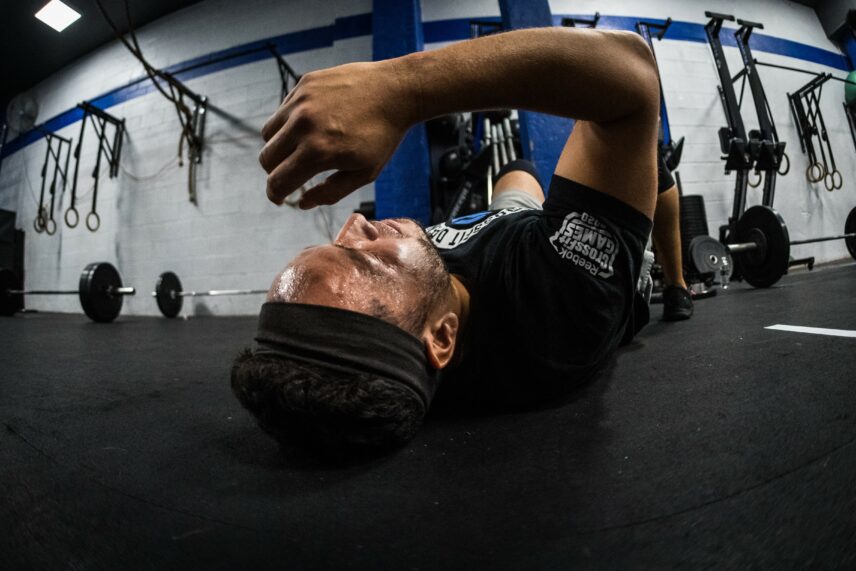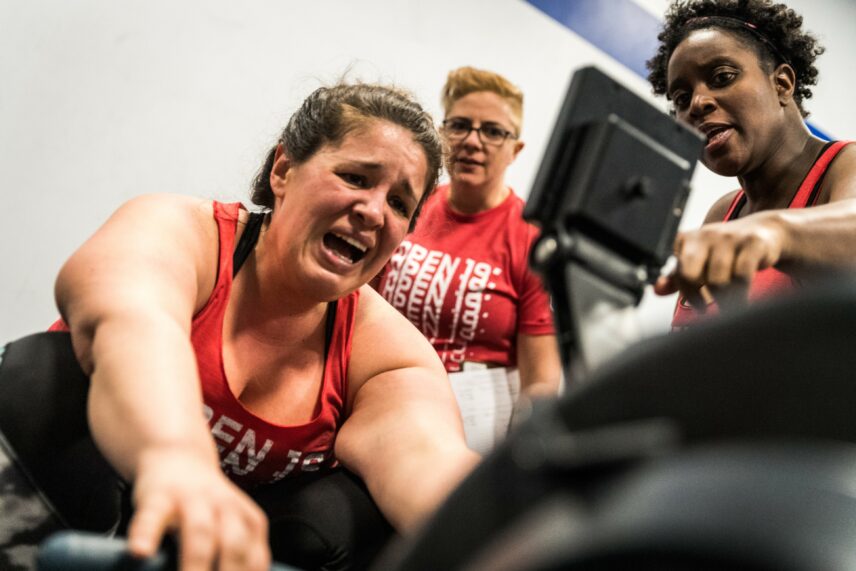Article begins
It begins the night before. I check the website for tomorrow’s Workout of the Day (WOD). What will it be? How much will it hurt? The workout is a tough one called Fran. Will I puke from exertion? Will I get “Fran lung”? I shouldn’t have checked the website, now I won’t sleep.
The logic of CrossFit is that workouts are variable (different each time), intense (hard), and functional (use movements that reflect everyday tasks). And if you regularly attend an hour-long group-fitness class you can complete a Hero or Girl workout, like Fran. Unlike sports where athletes practice their specific events, CrossFit emerged as a fitness regimen to train Navy SEALs and first responders, those performing warrior tasks, not playing games. It prides itself on preparing participants for extreme body and mind challenges with its daily workouts often published on the gym’s website the night before. Can you adapt to the extreme workout thrown your way? How will you push through?
I’m anxious throughout the night and at the gym the next morning. My heart is pre-workout racing. My hands are pre-exertion sweaty. How can I approach Fran, which requires a strong grip, with sweaty palms? How can my heart withstand Fran if it is already hammering in my chest? Chalk should help my palms. A deep breath should slow the heartbeat. They don’t help enough.
“3…2…1…Go!™” yells coach, as the clock beeps for each second and then louder on the “go.” My heart spikes and my stomach drops.
“This hurts so bad,” I think, two minutes into the workout of 21 thrusters (front squats with a barbell that you then thrust overhead), followed by 21 pull-ups, then 15 of each in sequence, and, finally, 9 of each. My muscles are burning with pain, filled with lactic acid. Lactic acid build-up is a biological process: as the body moves, muscles metabolize energy and produce lactate. Lactate can generate more energy, unless the body is producing more of it than it can expel, and it builds up in the blood. As lactate accumulates, the blood becomes acidic, which the brain identifies as a toxic environment. To detoxify and find equilibrium, the body expels excess lactate, sometimes through vomit. Fran, the workout of 21-15-9 thrusters and pull-ups, is famous for making people vomit.
I stand akimbo, the classic out of breath pose, and strategize how to finish without vomiting. I want to stop. Will I find a way to keep going?
CrossFitters in the United States sign up and pay a lot of money to push themselves to punishing points of exertion alongside others before or after a day of professional office work. We aren’t actually training for war; we are just practicing as if we were.
I stumble to the pull-up bar for the last time. I have nine pull-ups left. My anxiety is gone. Now all I feel is pain and a deep desire to finish, to make it all stop. I pull my body up four times. I drop down. I look at the clock, it’s at four minutes. Hoping to finish this workout in 20 seconds, I jump back up and do two more. I drop down. I take a deep breath and jump back up. I pull my body up twice. I hold onto the pull-up bar, negotiating with myself, “If you do it one more time you won’t have to jump up and down again.” I pull hard but I can’t get my chin above the bar for a full rep. I drop.
“Katie, FINISH!!” Coach screams.
I jump up and pull as hard as I can, feverishly kicking my legs to propel myself up and make my chin go over the bar. I do. I let go and collapse on the ground. The workout took me less than five minutes. Everything in me hurts.
When anxiety and desire are gone, I’m available to feel all the pain I have just inflicted on myself. My head is pounding. My face is bright red. My legs and arms, swollen with lactate, pulse with my racing heart. I feel the familiar muscular burning sensation. I haven’t vomited but for the next two days I will cough as I breathe. CrossFitters calls it “Fran lung,” because it is associated with this workout; to medical scientists it is “exercise-induced pulmonary edema”: when the lungs can’t keep up with the heart, fluid builds up in them. Coughing is the body’s reflexive act to help expel the fluid.

We lay around on the ground, cursing the pain as we move, talking about our times: Did we go faster than the last time we did Fran? Did we take fewer akimbo breaks? Where did we go wrong?
“I’m not coming tomorrow,” someone says.
“You should. Move your body around, it’ll help you recover,” someone replies.
Coach yells to herd the next group of CrossFitters into a circle. We watch them, anxiety written on their faces. Coach looks at our gaggle of human debris and dismisses us with an “I’ll see you tomorrow.”
At the turn of the twenty-first century, CrossFit emerged as a rogue exercise method that demanded participants tap into a “primal” need to be extremely physical, in the words of journalist-CrossFitter J. C. Herz, finding “redemption in their willingness” to be so. CrossFit fashioned itself as an activity that makes one feel alive through enduring physical pain; this intensity, so CrossFit lore goes, is what it means to be human and is missing from our modern, boring lives. As Herz puts it, “I do not live in the Paleolithic. I have all of the gadgets and creature comforts of a plush, sedentary, chronically ill society. And I can’t help but believe that the path out of physiological purgatory [is through CrossFit].” Herz uses Christian (purgatory, redemption) and evolutionary (modernity, the Paleolithic) frames to articulate CrossFitters’ desires for a primal, physical, painful experience. CrossFit, and these frames, have since morphed from special forces training into a popular, expensive fitness method for (mostly) white Americans through which the pursuit of physical pain and voluntary existential anxiety are felt and then disciplined. As fellow CrossFit enthusiast Amy tells me:
All of a sudden you realize how insane the workouts seem and it becomes this mental game. You set expectations for yourself in the beginning, based on your fitness level, then you get into it, then there’s a whole bunch of feelings and thoughts screaming inside your head: “Oh my god this is so hard,” “I can’t breathe,” “Oh, this is really heavy,” “I don’t know how much longer I can do this,” “Ok, no, keep going,” and like that whole journey of getting through any given workout becomes its own form of fitness, of mental fitness. [CrossFit] retrains you to think through any given situation and try and come up with a plan or strategies: “If this seems impossible, what am I going to do make it possible?” It is not a cure-all because anxiety is still very much a part of my day-to-day but at the end of the day CrossFit has made me better able to deal with highly stressful situations because of the way that you have to almost mentally trick yourself to get through some of the workouts that you do. And when you get to the other side…you are marveling at your own capabilities.
CrossFit develops mental fitness, a puzzling-through the emergence of disturbing feelings and thoughts to come up with a plan to deceive oneself to move from anxiety and pain to “Ok, no, keep going.” I’ve argued elsewhere that CrossFit allows elite white Americans to deal with apocalyptic fears that their world of power and privilege is coming to an end. By conjuring and calming the anxiety of physical pain during workouts, my CrossFit associates and I practice managing existential anxiety and physical pain in the present.
CrossFit is designed to be anxiogenic, with its varied and intense workouts preparing warfighters for battle. CrossFit is also designed to calm this anxiety. Coaches program workouts to cultivate subjectivities that learn to push through pain and anxiety by thinking, “I have been training my body to suffer this pain, I can do this.” CrossFit also encourages the scaling of workouts, especially for white collar professional participants like me and my colleagues, to make any series of tasks achievable for any individual at their own level of competence. The mental game of WODs for most non-special forces participants is to find a way to push through and scale a workout so that it’s hard but doable, to be able to manipulate the situation and oneself to make the impossible possible.

The anxiety of CrossFit workouts is in conversation with the anxiety of ontological being. Analyzing anxiety in a small country, anthropologist Nutsa Batiashvili argues that anxiety, unlike other forms of worry or panic, is projected at outward objects but its ultimate source of fuel is the overdetermined potentiality of the self. Batiashvili builds on Martin Heidegger’s anxiety about being-in-the-world by arguing that being-in-the-world as any number of potential forms of me is what is problematic in anxiety. CrossFit workouts illustrate this form of anxiety. The painful experience of previous CrossFit workouts gives rise to the anxiety of future workouts: “What am I capable of?” “Will I be able to talk myself through the pain?” “Will I scale the workout correctly?” “Which me will show up to do Fran―the one who will push through the pull-ups or the one who will rest more?”
But CrossFit anxiety is a simulation or fantasy. One needn’t go to the gym or push oneself to puke or develop Fran lung. But people do, as a leisure activity. Why? Perhaps it’s a form of what sociologist Stephen Lyng calls edgework, a skillful negotiation of boundaries between life and death, chaos and disorder, during high-risk activities. Or maybe it’s pretend edgework, as the stakes are not life and death, but rather practice for the seemingly sharp edges of everyday life.
CrossFitters are probing anxiety in a voluntary, simulated high-stakes environment in order to practice managing anxiety. This prepares CrossFitters, like Amy, to handle highly stressful (varied, intense, anxiogenic) life situations outside of the gym. CrossFit’s high-intensity combinations of pull-ups, thrusters, burpees, deadlifts, and other exercises cause anxiety and elicit anxiety’s antidote. It requests the capable embodied self show up at the gym as rehearsal to brave a work meeting, have a tough conversation, or to manage one’s to-do list. What is interesting is that this braving and managing includes finding a way to scale a workout or work meeting so that it fits one’s capabilities.
The anxiety conjuring and calming in CrossFit is a privileged way of being in the world. The physical pain is not really a life-and-death experience and scaling the world to fit one’s capabilities means one is always proficient. Therefore, CrossFit is a way to play at thinking one is overcoming something dangerous rather than actually facing the existential anxiety of nonbeing. Always being capable―at the pull-up bar or barbell rack―is a way for elite white Americans to practice dealing with ontological anxiety by mobilizing existential privilege and power.
The day after Fran, we all show up, sore and coughing: “What’s the punishment today?” We will practice overcoming it, soldiers winning our simulated war with anxiety.

